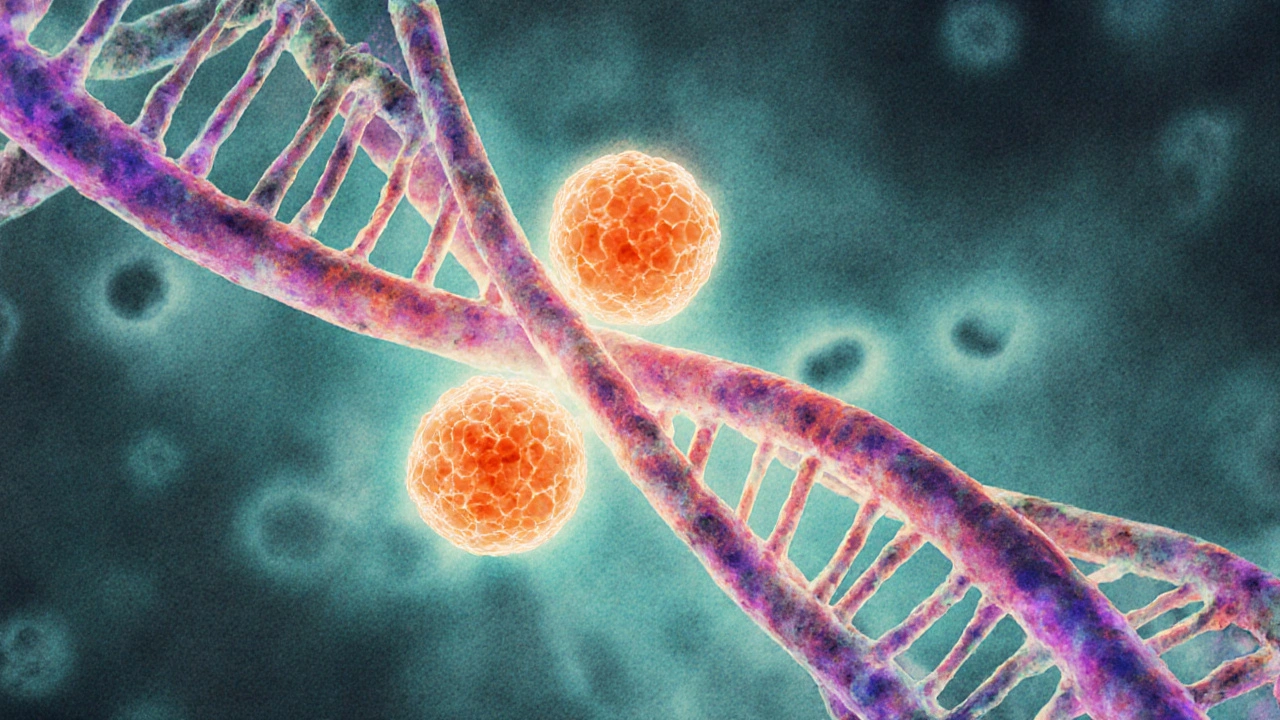Chemotherapy Agent Decision Guide
Choose Your Treatment Scenario
Recommended Agents
Note: This tool provides general guidance based on the article's information. Always consult with your oncologist for personalized treatment decisions.
Imagine facing a chemo decision and being handed a handful of drug names you’ve never heard of. Which one actually gives you the best chance at beating the disease without blowing up every other part of your body? This guide cuts through the jargon and puts Alkeran side‑by‑side with the most common alternatives, so you can see the real trade‑offs in plain language.
Key Takeaways
- Alkeran (melphalan) is an alkylating agent primarily used for multiple myeloma and certain melanomas.
- It works by forming DNA cross‑links that stop cancer cells from dividing.
- Common alternatives - cyclophosphamide, busulfan, chlorambucil, carboplatin - differ in potency, side‑effect profile, and disease focus.
- Choosing the right drug depends on cancer type, prior treatments, kidney function, and how aggressively you can tolerate side effects.
- Monitoring blood counts, staying hydrated, and coordinating with your oncology team are essential no matter which drug you end up on.
What Is Alkeran (Melphalan)?
Alkeran is a brand name for melphalan, an alkylating chemotherapy agent that adds a methyl group to DNA strands, creating cross‑links that prevent replication and trigger cell death. It was first approved by the FDA in 1964 and has become a cornerstone treatment for multiple myeloma and for high‑dose therapy before stem‑cell transplant.
How Melphalan Works Inside the Body
Melphalan belongs to the class of alkylating agents. These drugs attach an alkyl group to the nitrogen bases of DNA, most commonly at the N7 position of guanine. The resulting DNA cross‑link locks the two strands together, making it impossible for the cell to copy its genetic material. Cancer cells, which divide rapidly, are hit hardest, while slower‑growing normal cells experience collateral damage that shows up as classic chemo side effects.
When Doctors Choose Alkeran
Alkeran shines in two main scenarios:
- Multiple myeloma - often given as part of the “Melphalan‑Prednisone” regimen or as high‑dose conditioning before autologous stem‑cell transplant.
- Inoperable melanoma - especially when lesions are confined to the skin or subcutaneous tissue.
Because the drug is cleared largely by the kidneys, patients with reduced renal function need dose adjustments. That’s a key reason why some oncologists gravitate toward other agents in older or frail patients.

Common Alternatives to Alkeran
Depending on the cancer type, doctors may swap in one of these alkylators or related drugs:
- Cyclophosphamide - a pro‑drug activated in the liver, widely used for breast cancer, lymphoma, and as part of combination regimens.
- Busulfan - very potent, often used for chronic myeloid leukemia and as a conditioning agent before bone‑marrow transplant.
- Chlorambucil - gentler, historically used for chronic lymphocytic leukemia (CLL) and low‑grade non‑Hodgkin lymphoma.
- Carboplatin - a platinum‑based drug, preferred for ovarian, lung, and testicular cancers when cisplatin toxicity is a concern.
Each alternative brings a different balance of effectiveness, side‑effects, and administration logistics.
Head‑to‑Head Comparison Table
| Drug | Primary Indications | Mechanism | Typical Dose (mg/m²) | Key Toxicities |
|---|---|---|---|---|
| Alkeran (Melphalan) | Multiple myeloma, melanoma | DNA alkylation, cross‑linking | 0.25‑0.4 IV daily × 4‑5 days (high‑dose 140‑200 mg/m²) | Myelosuppression, mucositis, renal toxicity |
| Cyclophosphamide | Breast cancer, NHL, conditioning | Alkylation after hepatic activation | 600‑1000 IV q3‑4weeks or oral 50‑100mg/day | Hemorrhagic cystitis, alopecia, neutropenia |
| Busulfan | CML, transplant conditioning | DNA cross‑linking, very high potency | 0.8‑1.2mg/kg IV q6h × 4days | Veno‑occlusive disease, seizures, severe myelosuppression |
| Chlorambucil | CLL, low‑grade lymphoma | Alkylation, slower onset | 0.1‑0.2mg/kg oral daily × 7‑14days | Myelosuppression, GI upset, secondary malignancies |
| Carboplatin | Ovarian, lung, testicular cancers | Platinum‑DNA adducts | Area‑under‑curve (AUC) 5‑7 IV q3‑4weeks | Nephrotoxicity (less than cisplatin), ototoxicity, thrombocytopenia |
Pros and Cons of Alkeran
Pros
- High response rates in multiple myeloma, especially when used in high‑dose conditioning.
- Convenient oral formulation exists for low‑dose maintenance (though less common).
- Less alopecia than many other alkylators.
Cons
- Significant myelosuppression - patients often need growth‑factor support.
- Renal clearance makes dosing tricky in patients with impaired kidneys.
- Gastro‑intestinal toxicity (nausea, vomiting, mucositis) can be severe if anti‑emetics aren’t optimized.
Quick Look at Each Alternative
Cyclophosphamide is versatile and cheaper, but the risk of hemorrhagic cystitis means patients must stay well‑hydrated and may need mesna protection.
Busulfan packs a punch for transplant conditioning but carries a rare but life‑threatening risk of veno‑occlusive disease; therapeutic drug monitoring is a must.
Chlorambucil offers a gentler side‑effect profile for older CLL patients, yet its slower onset means it’s not ideal for aggressive disease.
Carboplatin reduces kidney damage compared to cisplatin, but thrombocytopenia can limit subsequent cycles, especially in patients with bone‑marrow involvement.

Decision Guide: How to Pick the Right Agent
- Identify the cancer type. Myeloma→Alkeran; lymphoma→Cyclophosphamide or Chlorambucil; transplant→Busulfan.
- Assess organ function. Good renal clearance? Alkeran is viable. Impaired kidneys? Consider Carboplatin or reduced‑dose Cyclophosphamide.
- Check prior therapy. If the patient already received high‑dose alkylators, swapping to a platinum drug may avoid cumulative toxicity.
- Balance efficacy vs. quality of life. High‑dose Alkeran offers deep remissions but needs aggressive supportive care. A milder agent might be preferable for frail patients.
- Discuss logistics. IV infusion schedules, need for drug‑level monitoring (busulfan), or oral adherence (chlorambucil) can influence the choice.
Safety & Side‑Effect Management
Regardless of the drug, the following steps keep you on the safe side:
- Baseline labs. CBC, renal panel, liver enzymes before each cycle.
- Avoid nephrotoxins. NSAIDs and contrast dyes can worsen melphalan’s renal impact.
- Hydration. Aim for at least 2L of fluid per day unless contraindicated.
- Growth‑factor support. Filgrastim or pegfilgrastim reduces neutropenia length after high‑dose Alkeran.
- Antiemetic regimen. A 5‑HT3 antagonist plus dexamethasone covers most nausea, while olanzapine can help breakthrough symptoms.
Practical Tips for Patients on Alkeran or Its Alternatives
- Keep a symptom diary - note mouth sores, fatigue, or any new bruising.
- Plan meals around anti‑emetics; small frequent meals reduce nausea.
- Bring a list of all meds to appointments; drug‑drug interactions (e.g., with warfarin) are common.
- Ask about fertility preservation early - alkylators can affect sperm and egg production.
- Stay on schedule for lab draws; missing a CBC can delay the next cycle and affect outcomes.
Frequently Asked Questions
Can I take Alkeran at home?
Low‑dose melphalan can be prescribed as an oral tablet for maintenance, but high‑dose regimens are always given intravenously in a clinic because of the need for close monitoring and hydration.
How does the effectiveness of Alkeran compare to cyclophosphamide in myeloma?
In frontline myeloma, Alkeran combined with prednisone (or as part of a high‑dose transplant) yields higher overall response rates (≈60‑70%) than cyclophosphamide‑based combos (≈30‑40%). However, cyclophosphamide may be chosen for older patients who cannot tolerate the renal strain of melphalan.
What are the main side effects to watch for with busulfan?
Busulfan’s signature toxicities are veno‑occlusive liver disease and seizures. Therapeutic drug monitoring keeps blood levels in a narrow window, and prophylactic anticonvulsants (e.g., levetiracetam) are standard during dosing.
Is carboplatin ever used for multiple myeloma?
Carboplatin is not a first‑line agent for myeloma; its activity is modest compared with melphalan. It might appear in clinical trials or as part of a salvage regimen when other options have failed.
How long does it take to recover blood counts after an Alkeran cycle?
Typically, neutrophil recovery (ANC>1.5×10⁹/L) occurs 10‑14days after the last melphalan dose. Platelet recovery can take 2‑4 weeks, which is why many protocols delay the next cycle until counts are adequate.
Next Steps
If you’re staring at a prescription for Alkeran or one of its alternatives, start by asking your oncologist these three questions:
- What is the goal of this specific drug in my overall treatment plan?
- How will my kidney and liver function affect dosing?
- What supportive medications (growth factors, anti‑emetics, mesna) will I need?
Write down the answers, bring a family member to the appointment, and keep a notebook for side‑effect tracking. Armed with the comparison facts above, you’ll be in a better position to weigh benefits against the risks and make an informed choice.






Chidi Anslem
October 13, 2025 AT 15:53When we talk about chemotherapy choices, it helps to step back and view the patient’s whole journey rather than just the drug label. Alkeran’s strength lies in its proven efficacy for multiple myeloma, especially as a conditioning agent before transplant. At the same time, its renal clearance means we must weigh kidney health carefully. Alternatives such as carboplatin or reduced‑dose cyclophosphamide provide softer toxicity profiles for patients with impaired function. Ultimately, the decision is a balance between disease control and quality of life, and that balance is unique for each individual.
Holly Hayes
October 17, 2025 AT 03:13i think people forget that chemo is not a one size fits all its not just about killing cells its also about how you live your life after the shot
Penn Shade
October 20, 2025 AT 14:33As anyone familiar with hematology will tell you, melphalan outperforms cyclophosphamide in achieving deep remissions for myeloma, and the data supporting high‑dose regimens is overwhelming. The pharmacokinetics are well characterized, and dose‑adjustment algorithms for renal impairment are already built into most treatment protocols. Ignoring these facts leads to suboptimal outcomes.
chris mattox
October 24, 2025 AT 01:53Let’s paint a picture: you’re navigating a dense forest of drugs, each with its own shade of risk and reward. Alkeran shines like a bright lantern for aggressive myeloma, while cyclophosphamide offers a softer glow for those who need gentler care. Carboplatin, with its sleek platinum backbone, slides in when kidneys beg for mercy. Think of the choice as mixing colors on a canvas – you want the right hue for the patient’s unique masterpiece.
Jackson Whicker
October 27, 2025 AT 13:13In the grand theatre of oncology, Alkeran stands as the tragic hero, bearing the weight of fierce efficacy while courting the specter of myelosuppression. Its mechanism, a delicate ballet of DNA cross‑linking, orchestrates cell death with a precision that rivals any maestro’s baton. Yet, the price of such power is the relentless onslaught on marrow reserves, demanding vigilant prophylaxis and heroic supportive care. Alternatives such as cyclophosphamide, though less flamboyant, provide a quieter intermezzo, sparing the patient from the bruises of severe cytopenias. Carboplatin, the silver‑tongued diplomat, negotiates renal safety while still delivering respectable anti‑tumor artillery. The wise clinician must weigh each act against the patient’s own narrative, recognizing that the most compelling story is not always the loudest but the most resonant within the individual’s lived experience. Therefore, when charting the therapeutic script, one must consider not only the drug’s stage presence but also the backstage crew of hydration, growth‑factor support, and anti‑emetic regimens. In the end, the choice becomes a dialectic between the poetry of potency and the prose of tolerability, a balance that defines true mastery in cancer care.
parag mandle
October 31, 2025 AT 00:33From a pharmacologic standpoint, melphalan’s alkylating prowess is unmatched for high‑dose conditioning before autologous stem‑cell transplant. Its dose‑response curve is steep, delivering deep cytoreduction when administered at 140–200 mg/m². However, the marrow toxicity is equally steep, often necessitating G‑CSF support and meticulous platelet monitoring. For patients with borderline renal function, a 20‑30 % dose reduction mitigates nephrotoxicity without sacrificing efficacy. When comparing to busulfan, melphalan offers a more predictable hepatic profile, avoiding the dreaded veno‑occlusive disease that can cripple transplant outcomes. In practice, the choice between these agents often hinges on prior exposure, organ reserve, and institutional familiarity with therapeutic drug monitoring.
Shivali Dixit Saxena
November 3, 2025 AT 11:53Take charge of your treatment plan! Stay hydrated, keep those labs up‑to‑date, and never miss a growth‑factor dose! Your body will thank you!!
Sandra Perkins
November 6, 2025 AT 23:13Sure, because side effects are just a minor inconvenience.
Craig Jordan
November 10, 2025 AT 10:33While the previous commentator dazzles with lofty metaphors, let us dissect the practicalities with a measured, albeit contrarian, lens. The premise that Alkeran’s high‑dose regimen is universally superior neglects the heterogeneity of patient comorbidities; many individuals simply cannot tolerate the accompanying neutropenia, irrespective of supportive measures. Furthermore, the assertion that carboplatin is merely a diplomatic alternative glosses over its propensity for profound thrombocytopenia, which can be equally detrimental in the context of marrow‑sparing strategies. One must also consider the economic dimension: cyclophosphamide, with its generic status, offers a cost‑effective pathway that many healthcare systems cannot ignore. In addition, the logistical burden of therapeutic drug monitoring for busulfan-though not directly comparable to melphalan-highlights an often‑overlooked facet of treatment planning: institutional expertise. Thus, the narrative is far more nuanced than a binary choice between potency and tolerability; it is a tapestry woven from pharmacodynamics, patient economics, and systemic capacity.
Jeff Quihuis-Bell
November 13, 2025 AT 21:53Let’s drill down on the supportive care needed for melphalan. Hydration protocols should start the night before infusion, aiming for at least 2 L of fluid unless contraindicated. Anti‑emetics must include a 5‑HT3 antagonist plus dexamethasone, and many clinicians add olanzapine for breakthrough nausea. Growth‑factor support with pegfilgrastim on day +2 can shave days off neutropenia, enabling the next cycle to stay on schedule. Mouth care is vital – a chlorhexidine rinse and magic mouthwash reduce mucositis severity. Remember to pause any NSAIDs to protect the kidneys, especially when melphalan is cleared renally. With these measures, the high‑dose shine becomes more manageable.
Tracy Winn
November 17, 2025 AT 09:13Honestly, the data on melphalan versus cyclophosphamide is crystal clear; melphalan delivers higher response rates, but the side‑effect profile can be a nightmare for patients with limited marrow reserve. Therefore, if the patient can’t handle intense myelosuppression, opting for cyclophosphamide-while perhaps less striking in efficacy-offers a smoother journey with fewer hospitalizations. Choose wisely.
Jessica Wheeler
November 20, 2025 AT 20:33The nuance lies in renal dosing: melphalan demands a 20‑30% reduction when creatinine clearance falls below 60 ml/min; carboplatin, by contrast, uses the Calvert formula, which inherently adjusts for kidney function. Overlooking this leads to avoidable toxicity.
Mikayla Blum
November 24, 2025 AT 07:53It's interesting how the community gravitates toward the most aggressive options; maybe because they think more intense = better, but that's not always the case :)
Mark Quintana
November 27, 2025 AT 19:13Observing the various regimens, one notes that the therapeutic window for melphalan is narrow, which makes precise dosing critical for maximizing benefit while minimizing harm.
Brandon Cassidy
December 1, 2025 AT 06:33Indeed, careful titration based on organ function and prior exposure can tip the balance toward a more favorable outcome without overwhelming the patient.
Taylor Yokum
December 4, 2025 AT 17:53Let’s keep the conversation grounded: for anyone wrestling with kidney concerns, discussing dose adjustments early with the oncology team can prevent surprises later. A supportive, transparent approach helps patients feel empowered throughout their treatment journey.